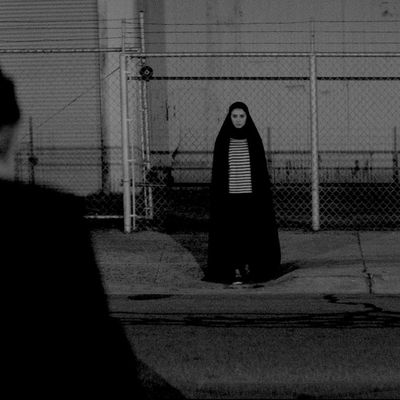
I can’t decide if Ana Lily Amirpour’s A Girl Walks Home Alone at Night is the most original film of the year, or the most familiar. A glance at the concept — a black-and-white Iranian feminist vampire Western romance, shot entirely in Farsi somewhere in Southern California — would suggest the former. And to be fair, it’s wonderfully inventive filmmaking: Amirpour’s striking compositions borrow from the iconography of both the Western and the horror film — wide, evocative vistas are intercut with dark, tense city streets where shadowy figures follow one another. But the director also draws playful connections between these genres and the symbols of modern Iran: Oil derricks spot the landscape, and the chador becomes an unlikely horror vestment. The whole movie exists in a netherworld that is impossible, but somehow also feels right.
The story Amirpour tells is full of familiar, perhaps even generic elements. Arash (Arash Marandi), a romantic young handyman and gardener, lives with an addict father (Marshall Manesh) and is tormented by Saeed (Dominic Rains), a sneering, tatted-up drug-dealer/pimp/all-around bad guy, in a beautifully desolate town called Bad City that seems perpetually cloaked in night. Meanwhile, a mysterious and quiet girl (Sheila Vand), part hipster and part black-clad avenging angel, wanders the streets exacting justice and revenge with her beautiful fangs. There’s drugs, there’s slow-motion dancing, there’s a body count, there’s a vintage car that it took Arash 2,191 days to save up for, and there’s a meet-cute (Arash is dressed as Dracula when he finally meets the Girl). In its broad strokes, there’s nothing here we haven’t seen before. It’s old-school Americana given a Persian twist — elemental stuff, and if you’re looking for a new story, look elsewhere.
So it may not be deep. But dear lord, is this movie gorgeous. Whether she’s framing a static landscape or a close-up of someone gyrating to some infectious bit of Farsi pop, Amirpour invests each shot of her film with precision and wonder. There’s a bit of Eraserhead in here, and some early Jim Jarmusch: The story may be spare and familiar, but the characters’ submersion invests each moment with an oblique mystery. Look at Sheila Vand’s eyes, and how they seem to hover forever between pleading and assertive; that conveys more than reams of character exposition ever will. Look at the hesitation with which she and Arash approach each other. Or the grim, nostalgic reverie in which Arash’s strung-out, deadbeat widower father wallows, seeking a narcotic cocoon that’s both pathetic and touching. In a movie like this, glances, spaces, and movement mean more than dialogue or plot. We experience A Girl Walks Home Alone at Night through its surfaces. But if that’s not the essence of cinema, I don’t know what is.


